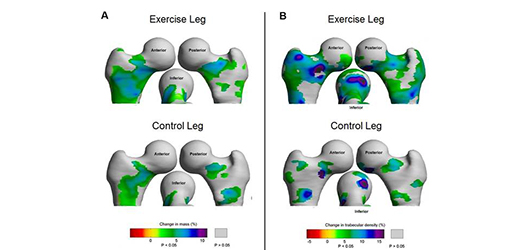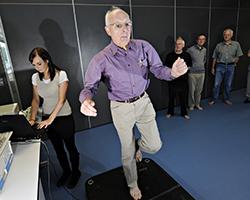Latest news from Loughborough University

10 Sep 2015
Hopping could reduce fracture risk for older people

Just two minutes of hopping a day can strengthen hip bones in older men and reduce the risk of fracture after a fall, a Loughborough University-led study has found.
The Hip Hop study, which measured the effect of daily hopping exercises in 34 men over 65, has shown bone density in the hopping leg improved after just one year.
Increases of up to 7% were identified in the bone mass of some parts of the outer shell (cortex) and in the density of the layer of spongy bone underneath this. Importantly, there were improvements in the thinnest areas of the bone most at risk of fracture after a fall.
The results have major implications for the prevention and management of osteoporosis (also known as the fragile bone disease), which affects an estimated three million people in the UK.
Bones thin naturally with age, and localised thinning in the hip is associated with an increased risk of hip fracture. The Hip Hop study has shown regular exercise can help counteract the effects of ageing to the bone.
Dr Sarah Allison, who conducted the research at Loughborough University’s National Centre for Sport and Exercise Medicine (NCSEM), said: “Hip fractures are a major public health concern among older adults, incurring both high economic and social costs. Those affected suffer pain, loss of mobility and independence, and increased risk of death.
“We know exercise can improve bone strength and so we wanted to test a form of exercise that is both easy and quick for people to achieve in their homes.”
Participants performed a series of daily hopping exercises incorporating different multidirectional movements designed to distribute a variation of stresses and strains throughout the proximal femur (hip). Hopping was selected over jumping to ensure comparisons could be made between legs.
CT scans, taken at University Hospitals Leicester, were analysed by a novel bone mapping technique developed at the University of Cambridge and showed clear visual differences between the exercise and control legs.
Dr Winston Rennie, the consultant radiologist involved in the study who supervised the CT scans, said: “The bone maps show clear changes in bone, with localised adaptions at regions that may be important to reducing hip fracture. Advances in imaging can allow further research in osteoporotic patients to understand the full impact of our findings.”
Consultant rheumatologist Dr Ken Poole, who led the bone mapping analysis at Cambridge added: “In percentage terms, the improvements we saw in these healthy men after just one year of hopping compare favourably to bone gains induced by osteoporosis drugs in women with fragile hips. However, we don’t yet know if men and women with osteoporosis would get the same benefits, or even whether the exercises would be safe for them to do, which are important research questions.”
Dr Katherine Brooke-Wavell, lead researcher at Loughborough University, provides a note of caution. She said: “Our volunteers were screened, and built up the exercises gradually. It is important to exercise carefully, as falling could cause a fracture in someone with weak bones.
“However, over time, our study shows that brief hopping or jumping exercises that target specific regions of the hip, could increase bone strength and reduce the chances of hip fracture.”
The study was funded by a Medical Research Council interdisciplinary bridging award, and the bone mapping analysis by the National Osteoporosis Society.
Notes for editors
Article reference number: PR 15/170
The Influence of High Impact Exercise on Cortical and Trabecular Bone Mineral Content and 3D Distribution Across the Proximal Femur in Older Men: A Randomised Controlled Unilateral Intervention is published in the September issue (Vol. 30, Issue 9) of the leading bone journal, the Journal of Bone and Mineral Research.
Loughborough is one of the country’s leading universities, with an international reputation for research that matters, excellence in teaching, strong links with industry, and unrivalled achievement in sport and its underpinning academic disciplines.
It has been awarded five stars in the independent QS Stars university rating scheme, putting it among the best universities in the world, and was named University of the Year in the What Uni Student Choice Awards 2015.Loughborough is consistently ranked in the top twenty of UK universities in the Times Higher Education’s ‘table of tables’ and is in the top 10 in England for research intensity. It was 2nd in the 2015 THE Student Experience Survey and was named Sports University of the Year 2013-14 by The Times and Sunday Times. In recognition of its contribution to the sector, Loughborough has been awarded seven Queen's Anniversary Prizes.
In 2015 the University will open an additional academic campus in London’s new innovation quarter. Loughborough University London, based on the Queen Elizabeth Olympic Park, will offer postgraduate and executive-level education, as well as research and enterprise opportunities.
Contact for all media enquiries
Amanda Overend
PR Manager
Loughborough University
T: 01509 228697